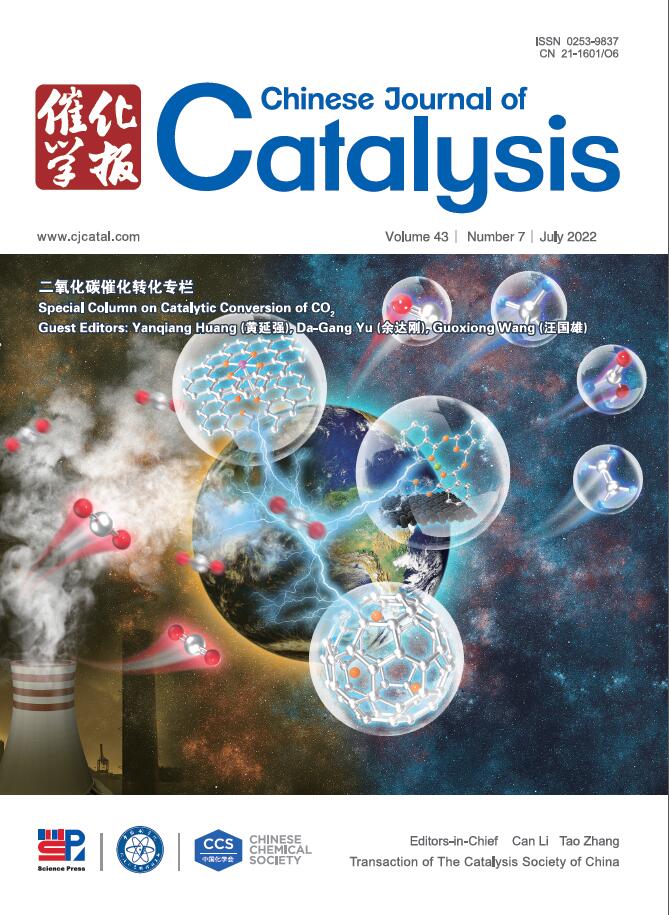Unveiling the catalytic active sites of iron-vanadium catalysts for the selective oxidation of methanol to formaldehyde
IF 15.7
1区 化学
Q1 CHEMISTRY, APPLIED
引用次数: 0
Abstract
Iron-Vanadium (FeV) catalyst showed a unique catalytic activity for the selective oxidation of methanol to formaldehyde; however, due to its complex compositions, the identification of catalytic active sites still remains challenging, inhibiting the rational design of excellent FeV-based catalysts. Here, in this work, a series of FeV catalysts with various compositions, including FeVO4, isolated VOx, low-polymerized VnOx, and crystalline V2O5 were prepared by controlling the preparation conditions, and were applied to methanol oxidation to formaldehyde reaction. A FeV1.1 catalyst, which consisted of FeVO4 and low-polymerized VnOx species showed an excellent catalytic performance with a methanol conversion of 92.3% and a formaldehyde selectivity of 90.6%, which was comparable to that of conventional iron-molybdate catalyst. The results of CH3OH-IR, O2 pulse and control experiments revealed a crucial synergistic effect between FeVO4 and low-polymerized VnOx. It enhanced the oxygen supply capacity and suitable binding and adsorption strengths for formaldehyde intermediates, contributing to the high catalytic activity and formaldehyde selectivity. This study not only advances the understanding of FeV structure but also offers valuable guidelines for selective methanol oxidation to formaldehyde.
揭示了铁钒催化剂对甲醇选择性氧化制甲醛的催化活性位点
铁钒(FeV)催化剂对甲醇选择性氧化制甲醛具有独特的催化活性;然而,由于其复杂的组成,催化活性位点的识别仍然具有挑战性,阻碍了优秀fev基催化剂的合理设计。本文通过控制制备条件,制备了FeVO4、分离VOx、低聚合VnOx和结晶V2O5等不同组成的FeV催化剂,并将其应用于甲醇氧化制甲醛反应。由FeVO4和低聚合VnOx组成的FeV1.1催化剂表现出优异的催化性能,甲醇转化率为92.3%,甲醛选择性为90.6%,与常规钼酸铁催化剂相当。CH3OH-IR、O2脉冲和控制实验结果表明,FeVO4与低聚合VnOx之间存在重要的协同效应。增强了供氧能力和对甲醛中间体的适宜结合和吸附强度,具有较高的催化活性和甲醛选择性。该研究不仅促进了对FeV结构的理解,而且为选择性甲醇氧化制甲醛提供了有价值的指导。
本文章由计算机程序翻译,如有差异,请以英文原文为准。
求助全文
约1分钟内获得全文
求助全文
来源期刊

Chinese Journal of Catalysis
工程技术-工程:化工
CiteScore
25.80
自引率
10.30%
发文量
235
审稿时长
1.2 months
期刊介绍:
The journal covers a broad scope, encompassing new trends in catalysis for applications in energy production, environmental protection, and the preparation of materials, petroleum chemicals, and fine chemicals. It explores the scientific foundation for preparing and activating catalysts of commercial interest, emphasizing representative models.The focus includes spectroscopic methods for structural characterization, especially in situ techniques, as well as new theoretical methods with practical impact in catalysis and catalytic reactions.The journal delves into the relationship between homogeneous and heterogeneous catalysis and includes theoretical studies on the structure and reactivity of catalysts.Additionally, contributions on photocatalysis, biocatalysis, surface science, and catalysis-related chemical kinetics are welcomed.
 求助内容:
求助内容: 应助结果提醒方式:
应助结果提醒方式:


